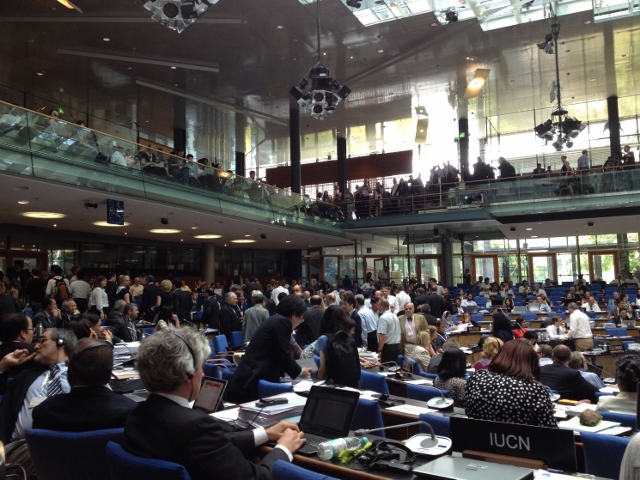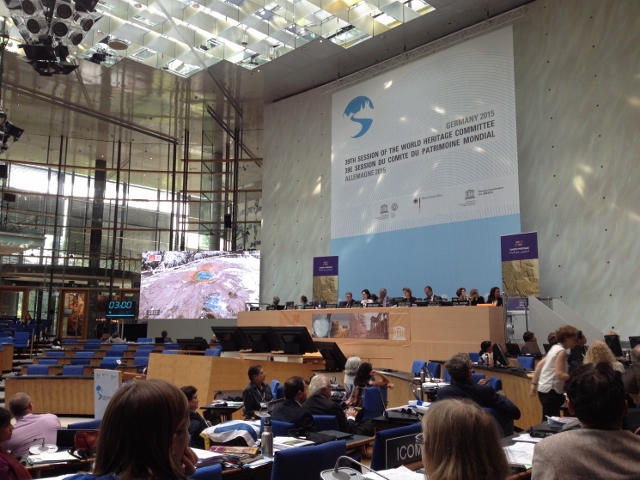自然保護寄附講座インターンシップ報告
筑波大学大学院人間総合科学研究科 世界文化遺産専攻 博士後期課程一年 渡邉真菜美
2015年6月28日(土)-7月8日(日) にドイツのBonnで開催された、第39回世界遺産委員会にIUCN World Heritage Programme Traineeとして代表団の一員として出席しました。
1. IUCN代表団の構成と役割
IUCN からの代表団は、スイスの本部メンバーに加え、アフリカ、中東、ヨーロッパなど地域オフィスの職員や、保全状況審査や新規推薦案件評価などの役割を担う専門家など、世界各国から総勢21名のチームとなりました。会期中の活動は、本会議での保全状況審査と新規推薦案件の評価の他、締約国代表との交渉、予算や作業指針の改定を議論する作業部会への参加、ウェブサイトやソーシャル・メディアでのコミュニケーションなど、本会議終了後もイベントやレセプション、締約国とのディナー出席などが毎日のようにありました。朝8:30のチームミーティングに始まり、ときには夜遅くまで充実した10日間でした。
2. インターンシップの仕事内容
私は2月にIUCN本部に着任し、世界遺産委員会の準備段階から、代表団派遣の事前準備・調整と現地での運営、サイド・イベントの計画・調整という、2つの業務に携わりました。
会期前の仕事
代表団派遣の準備:代表団参加者と連絡を取り、世界遺産委員会出席に必要な手続き、代表団のホテルの手配など旅行代理店との調整も行いました。会期中のスケジュール、本会議の議題、メンバーの役割、サイド・イベントのタイムテーブルなど重要な情報をまとめ、IUCN代表団のマニュアルを作成しました。
サイド・イベント:世界遺産の諮問機関であるIUCN、ICOMOS、ICCROMが主催するサイド・イベントについて、本会議の進捗、他機関のイベントとの重複などを考慮して日程や内容を詰めていきました。ICOMOS、ICCROMとイベントスペースを共有したため、この二機関と調整しながら時間の割振りを決めていきました。ICCROMに文化庁から出向している日本時職員の方が取りまとめを担当しており、一緒に仕事をすることができました。
会期中の仕事
代表団の予定管理とサイド・イベントの運営のほか、さまざまな依頼、トラブルシューティングに対応しました。本会議の議事の順番やサイド・イベントの予定などは当日でも変更・追加されるため、ウェブサイトや議場でのアナウンスなどに注意し、重要な変更があればチームメンバーにメールを流しました。チーム全体で把握すべき情報は私からの連絡に一本化することになり、非公式のレセプションや打ち合わせへの招待と日程調整の状況の把握も行いました。
その他、イベントやミーティングの時間・場所の問い合わせ、本会議の進捗状況の報告、議場での発表草稿などの印刷、食べ物・飲み物の買い出し(過密スケジュールと会議場周辺の環境から昼食等を各自で手配するのが難しかったため)、なかなか届かない宅配便の捜索、… 多岐に渡るリクエストがあり、どれも緊急なので、常にメールをチェックしながら本会議場とIUCNのオフィスの間を動き回り、一日の大半を過ごしていました。
3. 世界遺産委員会への参加を振り返って
学んだこと• 本会議裏の重要性: 今回の世界遺産委員会は、新規推薦案件が6件と少なかったこともあり、自然遺産の観点では比較的平穏なものでした。例年同様、保全状況の審査、新規推薦の評価で、IUCNの決議草案や勧告と異なる決議が採択されることはありましたが、極端にくつがえされるケースや議論が紛糾することはありませんでした。
一方、世界遺産委員会前から、また期間中も、締約国や世界遺産センターとIUCNの間で活発に話し合いが行われ、締約国の要望による決議草案の修正案や委員国が本会議で発言する内容について、ぎりぎりまで交渉が図られました。世界遺産委員会前に、関係者の間で合意形成がなされることが多く、本会議は公式見解を表明し、採択によって決議に国際的な効力を持たせる場といえます。チームメンバーは本会議と並行し数え切れないほどの交渉に駆け回っており、また会場建物のあちこちで深刻に話し込む各国代表の姿も見られ、本会議の背後で重要な動きが起こっているのを感じました。
• 世界遺産条約の意義: とくに世界遺産リストへの登録延期(deferral)、危機遺産リストへの登録など、締約国の利害に大きく関わる勧告の場合は、事前のすり合わせが各国間でなされ、本会議では委員国が総じて決議草案の修正を求めるのが常態化しています。今回も、セラード国立公園 (ブラジル) の危機遺産リスト登録が本会議で回避されたり、サンガネブ海洋公園 (スーダン) の登録延期(deferral)勧告が情報照会(referral)に引き上げられたりしましたが、IUCN代表団が冷静に受け止めていたのが印象に残りました。
チームメンバーからは、我々の目的は自然保護にあり、事前交渉の結果、締約国が遺産保護のために必要な処置や施策を取ることに合意するのであれば決議のかたちにはこだわらない、また、保護のために遺産の変化を監視し続けることに世界遺産委員会の重要な役割がある、と言った話が聞かれました。世界遺産条約が遺産保護のシステムとしてどのように動いているのか、IUCNが諮問機関としてどのように条約の目的を果たそうとしているのか、理解が深まりました。
• IUCNと世界遺産: 本会議での議論やサイド・イベントの計画・運営を通じて、自然遺産に関してIUCN、ICOMOS、ICCROMの3つの諮問機関が重要視しているテーマについて知ることができました。文化と自然のつながり、先住民と人権, NGOなど市民社会による世界遺産条約への参加, 登録申請前プロセス(Upstream Process), 原生自然の保護, 世界遺産地域からの利益…などです。これらはIUCNの保護地域関連の全体的な政策と連動しており、2014年11月にシドニーで開催された世界公園会議を踏まえ、2016年9月にハワイで開かれる世界自然保護会議に向けて、より重点的に取り組まれていく見込みです。IUCN代表団にはこのようなテーマを牽引している専門家が参加していたため、IUCNおよび世界自然遺産の最前線の動きを知ることができました。文化と自然とのつながり(Culture and Nature Linkages)などの議論が、今後どのように展開していくのか、IUCNを離れてからも追っていきたいと考えています。
• 世界遺産と政治:
今回の世界遺産委員会では、日本からの文化遺産の新規推薦案件をめぐる日本と韓国の対立が一つの大きなハイライトとなり、多くを考えさせられました。自分の国の世界遺産登録が他の国から望まれていないという現実、これまで明るいニュースだった世界遺産が国際的な政治・外交問題化してしまったことは、とても辛いものでした。会議場前での韓国市民団体によるデモンストレーション、日本の登録の議事が何度も延期され会場に懸念と好奇心が広がっていったこと、登録が決まったときの異様な静寂など、生々しく記憶に残っています。一方、登録に至るまでの一部始終を現場で目にしたのは貴重な経験でした。開催国ドイツの議長は、仲介役として世界遺産条約の意義である異なる文化間の理解を強調するかたちで議事を進め、今後の二国間や条約運営への影響を最小限に抑えられるよう、慎重に計画が練られたことが伺えました。最終的に両国ともに最大限の妥協を示し、またドイツが強いリーダーシップを示した結果、考えられるなかで最善の対応がなされたのではないかと、個人的には思っています。このような困難な事案が世界遺産委員会においてどのように扱われるのか、学ぶ機会となりました。
終わりに IUCN代表団の運営およびサイド・イベントの計画・調整などを通じ、代表団のメンバー全員と関わることができ、保全状況審査や新規推薦の評価、コミュニケーション、世界各地における保護地域関連の活動など、様々な領域に触れることができました。世界遺産条約の諮問機関としてのIUCNの仕事の全体像をつかむ上で意義深いものでした。普段一緒にいる本部スタッフだけでなく、多くの人が世界各国で自然遺産のために活動していること、国境を越えたネットワークの中でIUCNの世界遺産の仕事が成り立っていることがわかりました。二週間、チームメンバーを支えつつその仕事ぶりを近くで観ていたことで、世界遺産委員会における諮問機関の動きをリアルタイムで知ることもできました。さらに食事など一緒に時間を過ごす中で、メンバーそれぞれの世界遺産への考え方や、これまでの経験、現在取り組んでいる仕事について話を聞くことができたのも興味深いものでした。
IUCN代表団はオープンかつ打ち解けた雰囲気で、個性豊かな、とても楽しい顔ぶれでした。皆、大きな責任を抱え、締約国との交渉などプレッシャーも大きかったはずですが、いつも温かく私の状況を気にかけてくれていました。また、代表団のトップである上司も、責任のある役割を次々と与えてくれ、こちらの考え方も尊重し、いざとなれば前に立って話を進めてくれるなど、様々な配慮をしていただきました。忙しい会期中も折々で感謝や気遣いを伝えてくれ、二週間を乗り切る上で大きな励みとなりました。仕事への姿勢やチームのまとめ方など、上司からは多くを学びました。
世界遺産委員会ではIUCNのチームの面々に支えられ、一生に残る経験を得ることができたと感じています。インターンシップの終了まで残りわずかですが、貴重な機会を提供してくれたチームに感謝し、引き続きできる限りのお手伝いをさせてもらいたいと思っています。
4. Pictures
1) IUCN代表団グループ・セルフィ
会場内のIUCNオフィスにて。これも一応、世界遺産委員会での
コミュニケーション*の計画の一環です。人数が多く、残念ながら吉田先生は写っていないようです。。
コミュニケーション*世界遺産委員会でのIUCNの活動やニュースを広く一般やメディアに伝える、プレス・リリース、ウェブ・ストーリー、ブログ、ソーシャル・メディア(Facebook, Twitter)など。
専任スタッフが計画を立て、会期中の議事の進行に応じて情報を発信していきました。

2) 本会議場 IUCNデスク
日本の新規登録が決定した審議の終了直後。一列前方に日本政府代表団の席。

3) IUCNデスクから見た本会議場の演台
4) サイド・イベントの様子
5) IUCN オフィス
6) “Green Machine”
世界遺産委員会恒例、自然遺産関係の専門家(IUCN、各国代表、NGOなど)が集まるディナー。カジュアルな服装、政治家や外交官は入れないことが特徴。左から三人目がTim Badman、左端がLos Katios国立公園が危機遺産リストから除外されたコロンビアの代表、右から二人目がディナーの主催者でドイツ環境省のトップ。日本の環境省、林野庁の方々も参加されていました。